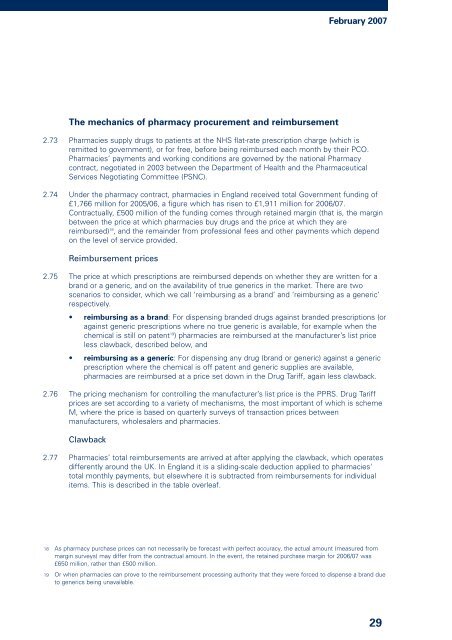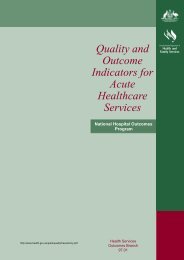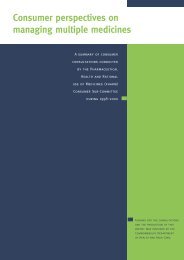The Pharmaceutical Price Regulation Scheme - Office of Fair Trading
The Pharmaceutical Price Regulation Scheme - Office of Fair Trading
The Pharmaceutical Price Regulation Scheme - Office of Fair Trading
Create successful ePaper yourself
Turn your PDF publications into a flip-book with our unique Google optimized e-Paper software.
February 2007<br />
<strong>The</strong> mechanics <strong>of</strong> pharmacy procurement and reimbursement<br />
2.73 Pharmacies supply drugs to patients at the NHS flat-rate prescription charge (which is<br />
remitted to government), or for free, before being reimbursed each month by their PCO.<br />
Pharmacies’ payments and working conditions are governed by the national Pharmacy<br />
contract, negotiated in 2003 between the Department <strong>of</strong> Health and the <strong>Pharmaceutical</strong><br />
Services Negotiating Committee (PSNC).<br />
2.74 Under the pharmacy contract, pharmacies in England received total Government funding <strong>of</strong><br />
£1,766 million for 2005/06, a figure which has risen to £1,911 million for 2006/07.<br />
Contractually, £500 million <strong>of</strong> the funding comes through retained margin (that is, the margin<br />
between the price at which pharmacies buy drugs and the price at which they are<br />
reimbursed) 18 , and the remainder from pr<strong>of</strong>essional fees and other payments which depend<br />
on the level <strong>of</strong> service provided.<br />
Reimbursement prices<br />
2.75 <strong>The</strong> price at which prescriptions are reimbursed depends on whether they are written for a<br />
brand or a generic, and on the availability <strong>of</strong> true generics in the market. <strong>The</strong>re are two<br />
scenarios to consider, which we call ‘reimbursing as a brand’ and ‘reimbursing as a generic’<br />
respectively.<br />
• reimbursing as a brand: For dispensing branded drugs against branded prescriptions (or<br />
against generic prescriptions where no true generic is available, for example when the<br />
chemical is still on patent 19 ) pharmacies are reimbursed at the manufacturer’s list price<br />
less clawback, described below, and<br />
• reimbursing as a generic: For dispensing any drug (brand or generic) against a generic<br />
prescription where the chemical is <strong>of</strong>f patent and generic supplies are available,<br />
pharmacies are reimbursed at a price set down in the Drug Tariff, again less clawback.<br />
2.76 <strong>The</strong> pricing mechanism for controlling the manufacturer’s list price is the PPRS. Drug Tariff<br />
prices are set according to a variety <strong>of</strong> mechanisms, the most important <strong>of</strong> which is scheme<br />
M, where the price is based on quarterly surveys <strong>of</strong> transaction prices between<br />
manufacturers, wholesalers and pharmacies.<br />
Clawback<br />
2.77 Pharmacies’ total reimbursements are arrived at after applying the clawback, which operates<br />
differently around the UK. In England it is a sliding-scale deduction applied to pharmacies’<br />
total monthly payments, but elsewhere it is subtracted from reimbursements for individual<br />
items. This is described in the table overleaf.<br />
18 As pharmacy purchase prices can not necessarily be forecast with perfect accuracy, the actual amount (measured from<br />
margin surveys) may differ from the contractual amount. In the event, the retained purchase margin for 2006/07 was<br />
£650 million, rather than £500 million.<br />
19 Or when pharmacies can prove to the reimbursement processing authority that they were forced to dispense a brand due<br />
to generics being unavailable.<br />
29




